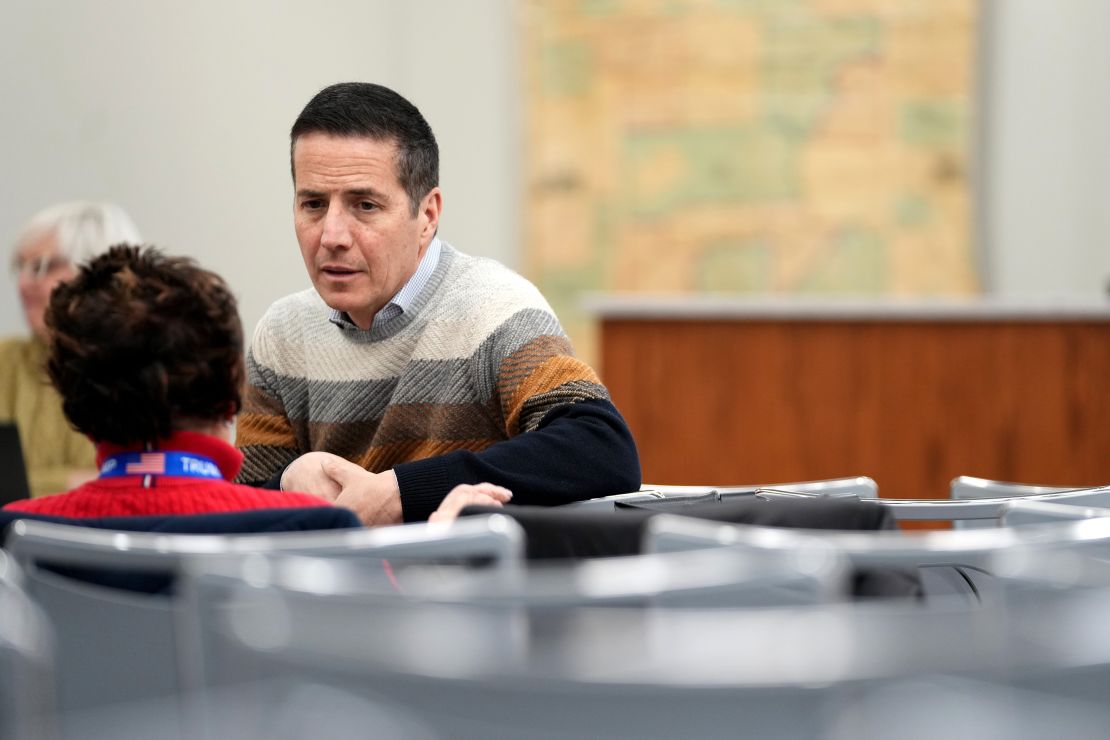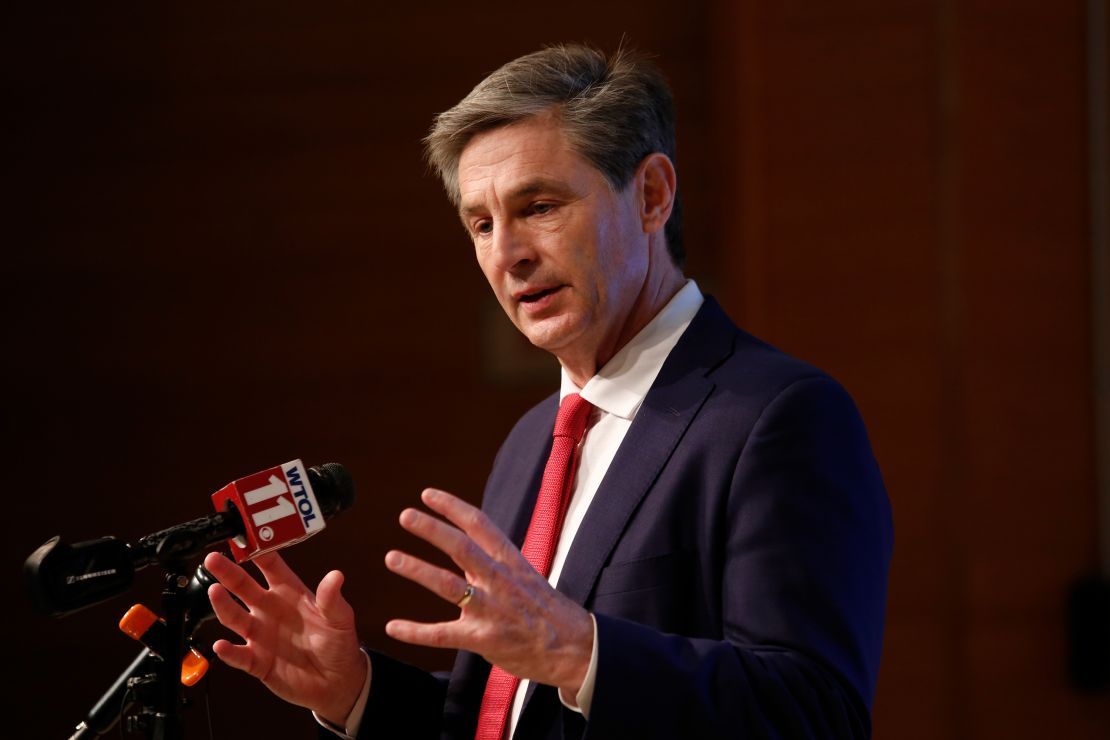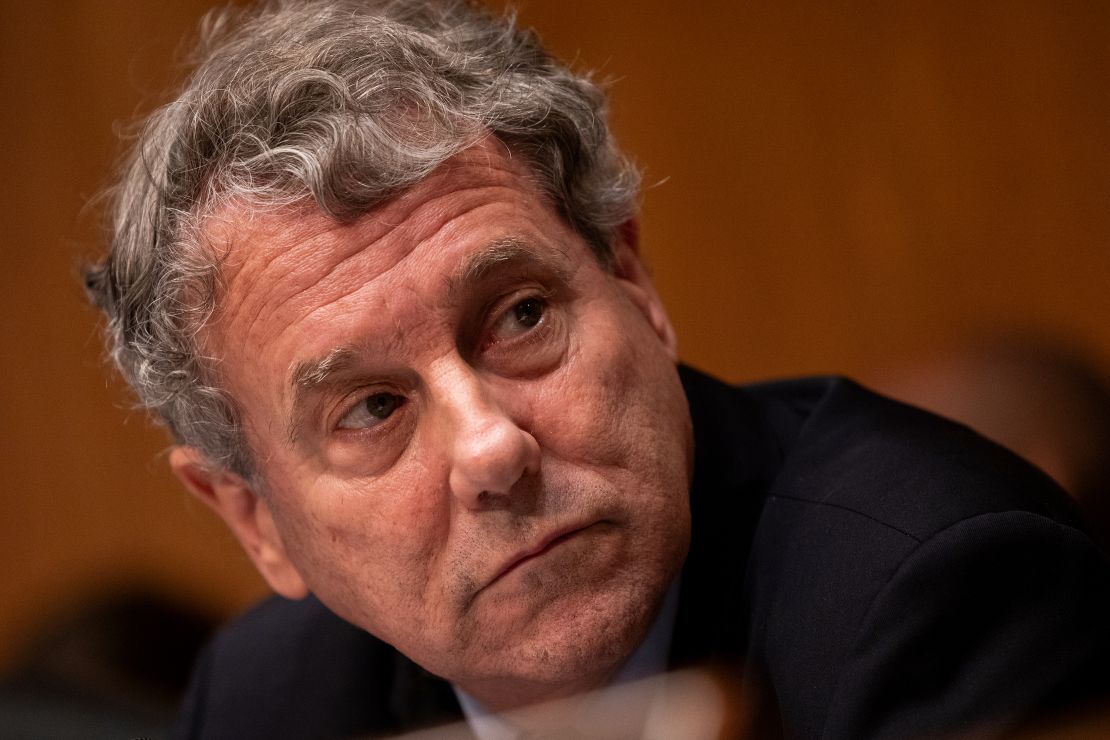Donald Trump would normally have little reason to be at a rally in Ohio – a state the presumptive Republican nominee twice carried comfortably – eight months before the November election.
But the former president’s endorsement, the most coveted in a GOP primary, hasn’t yet sealed the deal for businessman Bernie Moreno, who’s locked in a three-way primary that will be this year’s first test of Trump’s cachet in a contested Senate race.
Tuesday’s winner will take on Democratic Sen. Sherrod Brown – one of two Democrats running for reelection in Trump states whose fates are crucial to Senate control this fall.
Democrats are carefully eyeing the high-stakes Republican primary, with an outside group running ads that boost Moreno over state Sen. Matt Dolan and Secretary of State Frank LaRose. Their spending suggests they see Moreno as the preferred candidate to go toe-to-toe with Brown in a state that’s been trending red. The state went for Barack Obama in 2008 and 2012 before swinging to Trump four years later.
Though Trump appeared at a Saturday rally north of Dayton hosted by a super PAC supporting Moreno, national Republicans – who have endorsed in primaries in many of their other targeted seats this cycle – have stayed out of this race, believing that any of the three men can defeat Brown.
But Dolan recently secured the backing of two prominent Ohio Republicans – former Sen. Rob Portman and Gov. Mike DeWine. Their engagement has thrust into this race the split in the Ohio GOP between the Trump and more establishment wings, effectively pitting the two self-funding candidates against each other in the final stretch.
“So Bernie’s running against a weak RINO (Republican in Name Only) named Matt Dolan,” Trump said Saturday in a speech that was much more about himself than his endorsed Senate candidate. “He’s trying to become the next Mitt Romney,” Trump added, trying to tie Dolan to the Utah senator and 2012 GOP nominee, while ignoring LaRose.

As of Thursday, GOP campaigns and outside groups had combined to spend more than $34 million on the primary, led by Dolan, who had spent $9.6 million on ads, and Moreno, who had spent $7.8 million, according to AdImpact data. LaRose, a former Green Beret who started with early name recognition as the only statewide elected official in the race, hasn’t had the same personal resources to compete, but he has benefited from significant outside spending.
Not surprising for a GOP primary – even one more than 1,000 miles from Mexico – immigration has been a dominant theme in advertising, with candidates and their allies either touting their commitment to securing the border or attacking their opponents for supporting “amnesty.”
But amongst all that noise on TV, it may be the underlying fissures in the party that ultimately determine Tuesday’s primary – and what the fall matchup looks like.
“The big question mark in all of this: Who is that undecided category – is it the Trumpier side of the party or the less Trumpier side?” said Ohio Republican strategist Bob Clegg, who is not involved with any of the campaigns.
The Trump vs. DeWine dynamic
Trump has been omnipresent in Moreno’s campaign long before his Saturday rally.
“We love Ohio and we love Bernie Moreno,” Trump says in both the opening and closing of one ad from the Moreno campaign, in which the candidate says, “The first thing we have to do is we have to finish the wall.”
The former president backed Moreno, a Colombian immigrant who made a fortune from car dealerships, in December at the urging of Sen. J.D. Vance, who had been boosted by his own Trump endorsement in Ohio’s 2022 GOP primary (after which Moreno dropped out of that race).
But a recent ad from the Club for Growth’s political arm attacking Dolan was “the first clue something was up,” said Clegg. Then came the endorsement from DeWine, who had previously suggested he wouldn’t get involved in the Senate primary.
Both developments pointed to momentum for Dolan, who finished in a stronger-than-expected third place in that crowded 2022 race, when he had been the only candidate to reject Trump’s lies about the 2020 election. Trump had made clear early on in that cycle that he wouldn’t be backing Dolan, criticizing his family for changing the name of the Cleveland Indians to the Cleveland Guardians while calling him a RINO – an attack that the Club for Growth, which is backing Moreno, has picked up this year.

Trump again invoked the baseball team’s name change Saturday to take a dig at Dolan. “He’s easily pushed around by the woke left lunatics who renamed his family’s baseball team,” the former president said. “And my attitude is anybody that changes the name of the Cleveland Indians to the Cleveland Guardians should not be a senator, should not be a governor.”
While all three candidates have previously been more critical of Trump than they are now, Dolan is the only one who hasn’t endorsed Trump for president in 2024.
“Matt has been very clear that he’s very much in support of Trump’s policies,” said Chris Maloney, a strategist with the Dolan campaign.
The Dolan campaign has touted their Buckeye State endorsements – especially DeWine’s – in fundraising emails this week.
“They are servant leaders and they know how to win tough races,” Maloney said.
But Clegg noted that the late-breaking DeWine endorsement could be a “double-edge sword.” The governor’s support among seniors and more educated Republicans – who tend to be higher-propensity voters – could help Dolan, especially if Trump’s base isn’t enthused about turning out Tuesday because he’s already clinched the party’s presidential nomination.
At the same time, DeWine could also turn off some conservatives. Trump rebuked the governor for vetoing legislation that would have barred transgender youth from receiving gender-affirming care. DeWine also was a target of the right during the Covid-19 pandemic for following public health measures and other restrictions that Trump criticized.
“Everyone loves Mike DeWine, but that’s not where the party is right now,” said Ohio Republican consultant Bob Kish, who’s not working for any of the candidates.
There’s been plenty of money spent trying to tie each of the candidates to previous versions of the Republican Party – one that was less hardline on immigration, abortion and LGBTQ rights and more critical of Trump. As CNN’s KFile has reported, even Moreno said in 2016 there was “no scenario” in which he would support Trump and called him a “fake Republican.”
He sung a different tune at Saturday’s rally. “This is a good man. This is a great American,” Moreno said. “He loves this country like no other leader of this nation has ever loved this country.”
But that’s not unlike the about-face Vance made during the 2022 cycle.
“It’s the Trump candidate versus somebody else,” Kish said, noting the power of the former president’s endorsement to quell doubts about previous loyalty.
And that’s where Saturday’s rally comes in.
“Voters are tuning in and what they are going to be tuning into is Trump is endorsing Bernie,” said a senior strategist for the Moreno campaign.
The fight to defeat Brown
Whoever emerges from Tuesday’s primary, Brown is in for a tough race in a state that Trump twice carried by 8 points. But like Montana Sen. Jon Tester, the other Democrat running in a Trump state this year, he’s done it before.
Republicans need to flip just one or two seats – depending on who wins the White House – to control the Senate, and they’ve already effectively picked up one, assuming West Virginia Sen. Joe Manchin follows through on his announcement not to run for reelection.
The early money laid down in Ohio shows just how competitive both parties are expecting it to be. Senate Majority PAC, the super PAC tied to Democratic leadership, has reserved $65 million for TV ads – by far the most of any of the seven states where it made early reservations. On the Republican side, Senate Leadership Fund and an affiliated group have booked about $80 million.
Campaign resources will also be incredibly important in this race, especially since candidates receive more favorable advertising rates than outside groups. Brown raised nearly $5.7 million in the first two months of this year, ending the pre-primary reporting period with $13.5 million in the bank – far more than any of his would-be GOP challengers. Dolan and Moreno, however, have both loaned their campaigns millions of dollars, and there’s likely more where that came from.

Each Republican has their own theory about why they’re uniquely positioned to beat Brown. LaRose’s team, for instance, touts his statewide elected experience and service at the border and sees his lack of personal resources as a relative positive.
“Ohioans want someone they can relate to, who knows what it’s like to sit at their table and wonder how they’re going to pay their bills,” LaRose campaign communications director Ben Kindel said.
Dolan’s team champions his fiscal conservatism while arguing he can compete where the others cannot. “He can run aggressively in Ohio’s suburbs,” Maloney said, noting that Dolan had voted against a version of a so-called heartbeat bill in the state Senate because it did not include abortion exceptions for rape and incest, in addition to life of the mother.
Moreno has leaned into his background as an immigrant “who came here legally” and pitched himself as an “outsider” who hasn’t held political office and can unseat a three-term incumbent.
Besides Brown, no Democrat has won a nonjudicial statewide office in Ohio since 2008. He won his 2018 race by 7 points, but it was against a weaker GOP challenger who didn’t have major national party support.
Since then, the state has voted for Trump again, by the same margin. And this time, Brown will be on the ballot with him.
“I know for a fact he’s beatable,” said Clegg, who managed the only campaign to have ever beaten Brown – Bob Taft’s secretary of state race in 1990. “I think the biggest problem Sherrod is going to have – the general electorate has just changed so fast.”

But Democrats still see it as a competitive state. Two years ago, they forced Republicans to invest tens of millions of dollars in the 2022 race to hold an open seat, while Democrats won three competitive House seats. And since then, Ohio has passed a ballot measure enshrining abortion rights in the state constitution – an issue that the Brown campaign has already seized on as they try to paint all of the Republicans as too extreme and a threat to the will of Buckeye State voters.
“Democrats have shown every single time, with the exception of Hillary Clinton in 2016, that if all things are equal, or at least close to equal in terms of resources and engagement by the national party, that these races are competitive and winnable,” said a national Democratic strategist with experience working in Ohio.
They don’t deny Ohio has shifted more red – and that running on the ticket with Trump presents its challenges. But there are also opportunities in being a noncompetitive presidential state.
“The Senate race will be the main event in Ohio,” said a national Democrat working on Senate races. “That benefits Brown because his campaign will be the voice dominating the paid communications in the state, and voters won’t be getting hit by ads from the presidential race.”
This story has been updated with remarks from Saturday’s rally.
CNN’s David Wright contributed to this report.

